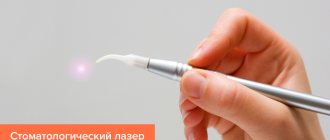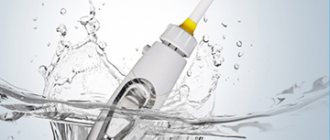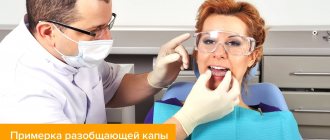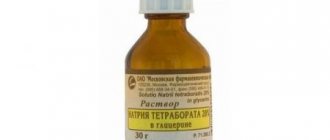Diode laser
Modern technologies are increasingly used in medicine. Today, laser treatment of periodontitis is commonplace. The healing properties of a narrowly targeted flow of energy are manifested in dentistry, creating the possibility of quick and painless dental treatment. The wide range of services provided with its help, coupled with relative affordability, contributes to the growing popularity of this method.
Areas of application of dental laser
The laser beam produces the following beneficial effects:
- anti-inflammatory;
- sterilizing;
- biostimulating;
- anesthetic.
Once on the surface of the tissue, the beam instantly turns the liquid into vapor, which, like a microscopic explosion, deliberately breaks intermolecular bonds layer by layer. At the same time, all microorganisms in the affected area die. To ensure that healthy cells do not suffer, jet air and water cooling is used, which also serves to wash out (blow out) the removed fragments.
A special type of laser equipment is used to treat each type of disease. Examples:
- Erbium and diode units are used against caries and for treating hard tooth tissues.
- Gas semiconductor devices have proven themselves to be excellent in physiotherapeutic and reflexology procedures.
- Diode lasers are characterized by a good hemostatic effect and have found their use in surgery.
The purpose of each device is determined by the wavelength of the radiation and its intensity. For example, biostimulation requires the release of energy from 10 - 100 mW/cm?, and the anti-inflammatory effect will provide a power of 100 - 200 mW per square centimeter.
Different stages of periodontitis
Indications and contraindications
Indications for treatment of the disease are both visual and tactile; these include:
- color change, enamel pigmentation;
- painful reaction to hot or cold, sweet or salty;
- enamel chipping;
- darkening of the cervical segment;
- carious cavity;
- a dark gap located along the border of the filling.
There are also contraindications to caries treatment:
- acute respiratory diseases;
- first and third trimesters of pregnancy;
- acute stage of periodontal disease, which is accompanied by severe bleeding of the gums;
- herpes in the acute stage.
Laser benefits
Due to its gentle impact, laser equipment is effective in solving almost all dental problems. It does not always replace a drill, but it successfully complements its work, since it can independently determine the affected areas, including those that are difficult to identify with the naked eye. The fact is that healthy tooth tissue does not contain moisture, and therefore boiling cannot occur in it. Many dental problems are resolved in just a few minutes and do not require a second visit to the doctor.
The beam is very thin and is able to penetrate microcavities that would otherwise require drilling with a bur. The radiation is directed to the desired location through a flexible and very thin quartz-polymer waveguide. The device itself is equipped with a compact, ergonomic head that can be easily operated by a trained physician.
Another advantage of the laser is that the surface processed by it acquires a slight roughness, which greatly improves the adhesion of the filling material. Reliable fixation reduces the likelihood of relapse to almost zero.
Precautionary measures
- Protect your eyes with special dark glasses.
- Before starting the procedure, remove all metal objects, as they, like a mirror, can reflect the laser beam and redirect it in the other direction.
- It is strictly forbidden to point the laser at fabric surfaces, as it is quite a fire hazard and can cause the surfaces to catch fire.
- Ask your doctor whether he has completed the necessary training courses and whether he has permission to use a dental laser unit in his medical practice. Otherwise, you risk becoming a victim of unqualified treatment, which can damage the health of your teeth.
Problems eliminated by laser beam
These properties allow the laser to be used to take the following therapeutic measures:
- removal of dental stones;
- treatment for periodontal diseases (gingivitis and periodontitis);
- getting rid of the consequences of caries and granuloma.
The disinfecting and biostimulating effect of using laser dental equipment makes it possible to fight the following infectious diseases:
- herpes rashes on the lips;
- aphthous stomatitis;
- ulcers;
- painful cracking in the corners of the mouth.
Practice has confirmed the high efficiency of laser equipment when performing the following therapeutic procedures:
- decreased sensitivity of enamel and its whitening;
- sealing fissures in children's teeth and correcting wedge-shaped defects;
- installation of implants;
- correction of various defects of the oral cavity.
It should be noted that getting rid of such a dangerous disease as granuloma using a laser beam is not accompanied by tooth extraction, but can be done conservatively, using transcanal dialysis:
- after analyzing the x-ray and external examination, a diagnosis is made;
- the canal (or filling, if it was previously installed) is opened, expanded and processed with aseptic material;
- a waveguide connected to the laser emitter is inserted into the prepared channel;
- the granuloma is exposed to the targeted beam for the required time;
- the liquid inside the granuloma evaporates, the capsule narrows, the tooth root is sterilized;
- the channels are disinfected and sealed;
- adhesive and filling material is applied.
Further, if there is a need for this, work is done to model the crown and install it.
The use of anesthetics and antibiotics is kept to a minimum, which is very important when treating children and adults prone to allergic reactions.
Laser treatment of patients is possible at the initial stage of periodontitis and is carried out in the following sequence:
- After diagnosis, the doctor removes plaque and hard deposits, including under the gum;
- Photoditazine is applied to the treated areas, which is washed off after 10 minutes;
- The laser emitter is directed to the subgingival area.
The treatment course involves two sessions with a six-month break.
METHOD 1: ICON infiltration method of dental treatment
The Icon procedure technique is based on the infiltration of tooth tissue with a polymer composition after the disinfection procedure.
The developers of the methodology are the DMG concern (Germany).
ICON is a gentle treatment method that involves the introduction (infiltration) of a polymer resin into the affected area of the enamel surface. The principle of operation of the described technique is based on the action of a special organic substance, with the help of which the part of tooth enamel affected by caries is treated. A carious stain on the surface of a tooth is covered with a composition (containing acid), as a result of which the enamel damaged by the carious process splits and becomes permeable. At the end of the process of creating enamel permeability, the acid gel is washed off from the tooth. The area of enamel affected by caries is dried. An organic polymer resin consisting of organic components is applied to the tooth. This composition fills the pores of tooth enamel formed as a result of etching and forms a monolithic structure. After the enamel is impregnated with resin, it is polymerized under the influence of a dental photopolymer lamp with halogen radiation. The resin hardens to form a protective layer on the enamel.
The technique allows you to preserve the strength of the enamel for a period of about 5 years. The material used to fill the enamel defect does not cause an allergic reaction and is biocompatible. Thanks to this polymer layer, cracks do not form on the surface of the tooth enamel for a long time, allowing pathogenic microorganisms to penetrate the surface layers of the enamel and contribute to the development of the carious process. The polymer resin has several shades, which allows you to choose a shade that fully matches the natural color of the tooth surface. On average, the ICON procedure takes about half an hour. Without any unpleasant sensations or discomfort, the superficial area affected by caries is completely eliminated.
Advantages of laser dentistry
One of the most important advantages of dental laser equipment is the absence of mechanical impact. Unpleasant sensations typical for treatment with a drill are eliminated, as is the occurrence of microdamages associated with vibration.
All operations are silent, but it is the buzzing of the drill that often puts patients in a stressful state.
With laser treatment of soft gum tissue, the incision sites are scarred much faster than with conventional surgical methods, since the incision is sterilized and instantly sealed. The duration of all operations is significantly reduced.
The laser has a powerful healing effect when removing a tooth. The operation itself is performed with conventional instruments, like any other extraction, but the tissue flaps cut by the beam are minimally injured, which significantly reduces the intensity of bleeding and speeds up healing.
The laser is also used in prosthetics to form a ledge above the gum, where the tooth tissue passes into the crown. The line turns out very clear, and the result pleases with its high quality.
The main advantage of using a laser in implantology is the precise thinness of the beam, which narrows the size of the surgical trauma inflicted on the patient. Damaged capillary blood vessels are sealed instantly due to targeted thermal effects.
Laser whitening is based on the principle of splitting pigments in dentin, which leads to almost complete discoloration of all coloring substances deeply embedded in the enamel structure.
Dental treatment without drilling.
SUPER NEW 2022!
Without drilling or enamel trauma, we treat:
- superficial and medium dental caries
- wedge-shaped tooth defect
- cervical dental caries
We have been using various non-drilling dental treatment techniques since 2006;
In this article, we will help you figure out which one is the best.
Some patients' fear of having their teeth drilled is forcing dentists and medical research centers to look for new treatment options.
An American study involving more than 10,000 patients suffering from dental phobia showed that patients are more afraid of the procedure of drilling teeth with a drill.
Often patients cannot explain what exactly about drilling scares them.
There are 4 methods in the arsenal of modern methods of dental treatment without drilling. They all have their advantages and disadvantages. In this article we will look at each and choose the best.
All the best for children
Laser therapy is successfully used in the fight against caries even in baby teeth, although only at the initial stage of the lesion. It is advisable for the child to be at least seven years old, but diligent and calm children can take advantage of the latest technology at a younger age.
For the treatment of small patients, the following rules apply:
- it is necessary to use only equipment with the ability to adjust the radiation power;
- During the procedures, a slight tingling sensation may occur, which the child should be warned about.
All other advantages of laser dentistry are common to children and adult patients.
Gallery of dental treatment without drilling
ALL IMAGES CLICK ENLARGE
Ozerov Petr Vladimirovich
Chief physician. Dentist, implantologist, orthopedist, surgeon. Laser dentistry specialist
More details
Werner Elena Vladimirovna
Dentist periodontist
More details
Eremina Anna Arturovna
Dentist therapist
More details
The SANDMAN system is recognized as the best method for treating wedge-shaped tooth defects. The advantages are obvious:
- no need to drill the tooth
- European-made equipment of PREMIUM class
- no need to treat the tooth with acid
- no tooth trauma from drilling (vibration and overheating)
- With this method of treatment, the restoration stays on the tooth 2-3 times longer!
- without stress and the smell of a burnt tooth.
The Bionic Dentis clinic was the first in the Russian Federation to use this innovative European method of dental treatment without drilling! Over the years of using this technique, we have treated more than 5,560 wedge-shaped defects.
We have accumulated vast clinical experience and guarantee you long-term results and the absence of complications.
Flaws
The need for a doctor to protect his eyes with special dark glasses significantly affects his ability to distinguish small details in the work area. There is also a danger of causing minor damage to the soft tissue of the gums, which heal rather poorly later. Therefore, working with a dental laser requires the dentist to have increased concentration and precision of all movements.
It is also necessary to adhere to safety rules when working with a laser; violation of them can cause irreparable damage to both the health of the patient and the health of the doctor himself.









